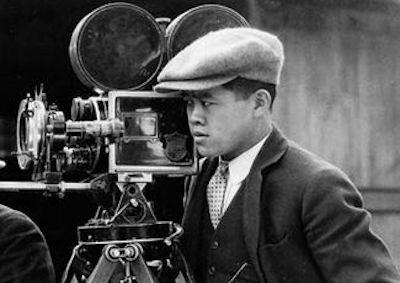Please review our required COVID-19 precautions and updated admission policy.
One of the most widely sought-after Hollywood Golden Age cinematographers was James Wong Howe (1899-1976), who, having shot over 130 features between 1923 and 1975, is today considered one of the most innovative directors of photography to ever work behind a camera. Born Wong Tung Jim in Canton Province, China, in 1899, Howe moved to America at the age of five and settled in southeastern Washington state, where an encounter with a Brownie camera at a local drugstore sparked his curiosity for photography. Arguably the first to make use of deep focus photography, namely in the pre-Code comedy Transatlantic (1931), Howe was consistently on the vanguard of technological ideation: he liberated stationary cameras with his version of a dolly for The Rough Riders (1927), choreographed early helicopter shots for Picnic (1955), and expanded fields of vision with extreme wide-angle lenses. Though his professional accolades continued to accumulate, with 10 Academy Award nominations and two wins for The Rose Tattoo (1955) and Hud (1963), the cinematographer contended with extreme anti-Asian racism throughout his life. Howe was denied United States citizenship until the 1943 repeal of the Chinese Exclusion Act, when the 44-year-old was already 20 years into a groundbreaking career in an industry that has historically made little room for non-white creatives. From Borzage to Hawks to Frankenheimer and dozens of others, Howe’s unique eye gave each of their films a distinct visual richness. The Archive is proud to present two films from our collection that highlight his masterful work with shadow and light.
Sweet Smell of Success
U.S., 1957
A free agent after his contract with Warner Bros. ended in 1946, Howe returned to United Artists in 1957 to join former collaborator Burt Lancaster, who was impressed by the D.P.’s Oscar-winning work on The Rose Tattoo, a film in which Lancaster also starred. To execute the distinct nocturnal look of this dramatic, damning portrait of human nature gone sour, Howe took direction from filmmaker Alexander MacKendrick, who was fresh off a stint at Ealing Studios in West London and his recent success with the black comedy, The Ladykillers. Modeled after photojournalist Arthur “Weegee” Fellig’s uncompromising images of street-level life in New York City, Howe’s prowess in etching with shadow adds a “crisp, threatening, noir-like” hardness to the city that MacKendrick was seeking for this biting satire. On location for just a few short weeks in Manhattan, the crew worked graveyard shifts, shooting between midnight and 6 in the morning to make use of the harsh lights that illuminate Times Square and Broadway. Perhaps as distinct are Howe’s cramped interiors, with jazz clubs and seedy office suites rendered three-dimensional through his masterful experience with deep focus techniques. The film is dominated by Lancaster as black-hearted Broadway columnist J.J. Hunsecker, who parses out small gossip items to sycophantic press agent Sidney Falco (Tony Curtis), who in turn uses such information to his unscrupulous advantage. Obsessed to extremes with controlling his own sister’s romantic life, Lancaster’s Hunsecker is a towering, teetering monster of Shakespearean proportions, rendered larger-than-life by Howe’s strategic camera maneuvers and shot compositions.
35mm, b&w, 96 min. Director: Alexander MacKendrick. Based on the novelette by Ernest Lehman. Screenwriters: Clifford Odets, Ernest Lehman. With: Burt Lancaster, Tony Curtis, Susan Harrison.
Seconds
U.S., 1966
Interested in blending science fiction and horror with the en vogue look of cinema vérité, a then-36-year-old John Frankenheimer enlisted veteran cinematographer Howe to visualize his adaptation of David Ely’s 1963 novel about a middle-aged, middle-class man desperate for a second chance at youth. Formerly blacklisted character actor John Randolph plays Arthur Hamilton, a frustrated banker who elects to undergo a mysterious procedure that will transform him into the younger, fitter painter Tony Wilson (Rock Hudson, playing distinctly against his matinee idol type). Nearly every production detail, from lenses and camera placement to set design and sound recording, gives Seconds its lingering, eerie sensibility. Often using multiple handheld Arriflex cameras and various fish-eye lenses to drastically distort the image, Howe realized the film’s unique aesthetic in collaboration with art director Ted Haworth, whose labyrinthic, warped sets aid in attaining the film’s unsettling, abstract mise-en-scene. Wide-angle lenses were harnessed to actors to create haunting tracking shots, and, due to the camera’s close proximity to actor’s faces, most of Seconds was shot without sound, adding further to its otherworldly aura. Owing more to the overseas innovators of the nouvelle vague than its Hollywood-adjacent birthplace, Seconds was met with shrugs and raised eyebrows upon its release into a theatrical landscape on the cusp of a New Hollywood desperate to liberate itself from the chaste Classical era. Today, the film’s black-and-white, avant-garde visual style, buttressed in no small part by Saul Bass’ demented opening credits, stands out among the glut of Hollywood Technicolor treacle that would telegraph its own spectacular demise.
35mm, b&w, 106 min. Director: John Frankenheimer. Based on the novel by David Ely. Screenwriter: Lewis John Carlino. With: Rock Hudson, Salome Jens, John Randolph.






 Mobile Navigation
Mobile Navigation

